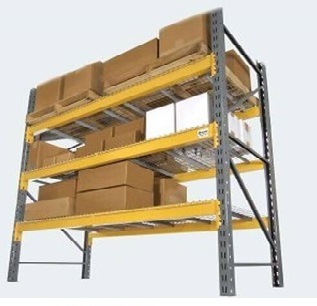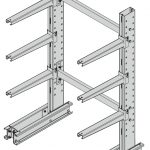What Constitutes a Bay of Pallet Racks?

When we’re talking about pallet racking, what do we mean when we refer to a “bay of pallet racks”? There are a couple definitions.
A bay of pallet racks can refer to a single standalone unit, one floor level and two beam levels. It can also refer to a starter unit with additional add-on units sharing their upright columns.
When determining how much space you have for a row of pallet racks, you need to allow for the growth (the width of the upright columns).
The basics of pallet racking
If you are having a hard time figuring out the type of pallet rack you will use with your warehouse, you should consider the basics. Measure the depth, height and width of the area you have and of standard selective pallet rack bays:
- Width:
The first thing you should look at is the width required out of the bay. A standard GMA pallet measures 40” wide. In the vast majority of applications you’ll find, a forklift will need at least five inches of width between each frame and the pallet, plus another six inches between pallets on double wide bays to allow for enough of a turning radius for loading and unloading the pallet rack system. With this in mind, you would take the width of the pallets (usually 40”, multiplied by two for the double wide system) plus five inches of space on one side plus six inches between pallets plus five inches on the other side to reach the bay width requirement. This means you would need a 96” bay width. - Upright depth:
Standard applications require the depth of the upright to be six inches less than the depth of the pallet. A standard GMA pallet is 48” deep. The pallet should stick out from the pallet rack beams by three inches in the front and three inches in the back. This allows the driver of the forklift a greater ability to set the pallet on the beams when loading material. As such, you would have 42” deep uprights in this standard example (48” of the pallet, minus the 6” of needed clearance). - Upright height:
A forklift needs at least a four-inch lift to be able to pick up and move a rack of pallets out of position in the pallet rack system. This four inches needs to be added to the height of the load, including the pallet, to calculate the total amount of clearance height needed below each beam. So if the pallet is a standard 40” size and you need that extra four inches of space, you need at least 44” to have clear height.
Keep in mind that these numbers can vary depending on the size of the available bays and the size of the pallets. Make sure you do the math for your warehouse space.
For more information about pallet racking and how to set up your bays in an efficient and safe manner, contact the team at Industrial Shelving USA today.
More...
Categorised in: Pallet Racks



